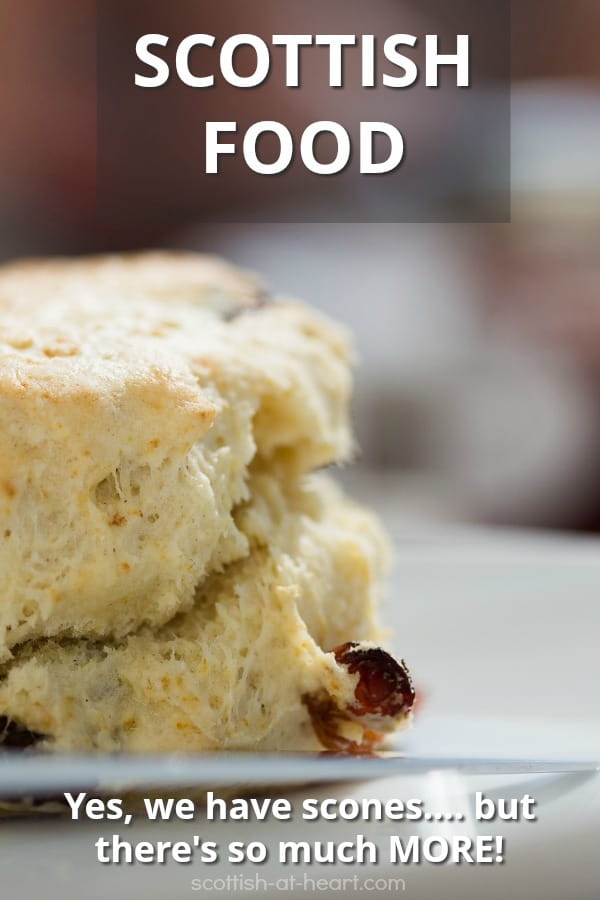Scottish Food - It's GOOD!
What comes to mind when you think of Scottish food?
Haggis? Shortbread? Porridge? If so, you wouldn't be wrong, but there's so much more, and some of it might surprise you.
The food of our native Scotland may not exactly have a reputation for being find dining, but it's tasty, filling, nutritious, and more diverse than most people realize.
Take a closer look at Scottish food and cuisine right here.
The History Of Scottish Food
The unique blend of races that make up the ancestors of todays' Scots (plus Scotlands' rich and diverse landscape) both played a huge role in shaping this part of Scottish culture.
It's believed that the first people who arrived in the north of Scotland somewhere between 800 BC and 1000 BC, were the Picts.
These ancient people were hunter-gatherers, as were the Celts who came next - and Mother Nature couldn't have provided for them better!
Scotland is a small country, but it has an abundance of water in the form of lochs (lakes), rivers, streams and, of course, the sea which surrounds the Scottish mainland and it's numerous islands.
It also has fertile soil, tons of natural resources and a fairly temperate climate.
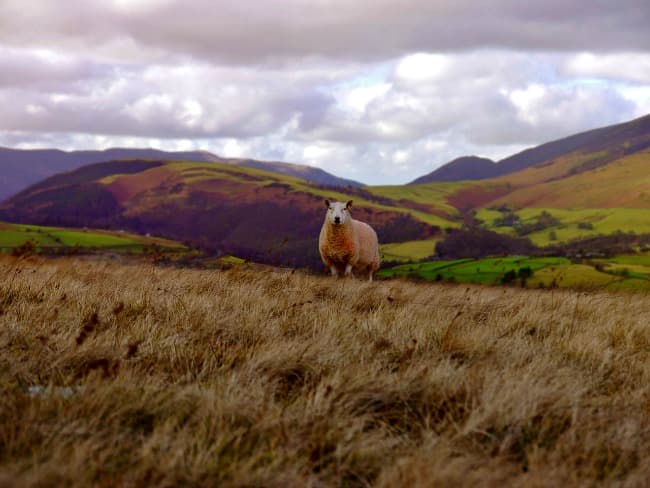
Hunting, fishing and raising sheep and cattle
provided the meat for meals, and the soil was perfect for growing oats
and barley, plus many root vegetables and soft fruits. This made
traditional Scottish foods a very healthy diet.
The arrival of the Vikings in Scotland (the first raid of Scotlands' northern isles is believed to have taken place towards the end of the 8th century), added new dimensions to the way Scottish food was preserved and cooked.
The Vikings brought the Scandinavian methods of 'salting' and 'smoking' to Scotland, and they soon became popular. It's also believed that the famous 'Aberdeen Angus' cattle originated from Viking stock brought with the raiders.
Here's a look at the main 'ingredients' of traditional Scottish meals....
- Meat
Beef (including that famous Aberdeen Angus), lamb and mutton, venison. The Scots don't traditionally eat much pork, (perhaps the occasional wild boar in bygone days), but pigs aren't nearly as popular as cows and sheep. - Game
Both the Scottish highlands and lowlands are full of wild game (although today there's less 'wild' game and some of it is 'farmed') including pheasant, grouse, partridge, pidgeon, hare, rabbit and more. - Fish and Seafood
The lochs and ocean provide a ready-made supply of food. Salmon, Haddock, Trout, Mackerel and Herring are probably the favorites, with plenty of fresh seafood/shellfish such as lobster, crab, prawns, scallops, mussels thrown in. - Crops/Grain
Oats and barley are the grains that you see most often in traditional Scottish food, probably because the soil and weather make great growing conditions. Wheat doesn't grow as well, but of course is now readily available. - Vegetable
Root vegetables such as potatoes, turnips and carrots show up in many savory dishes. Cabbage, cauliflower, peas and leeks are popular too. - Fruit
Soft fruits like blackberries (called brambles... I loved going bramble-picking!), raspberries and strawberries appear in many desserts ('sweets'), while apples and rhubarb make wonderful pies and 'crumbles'.
Centuries ago, stews, broths, soups, haggis, fish and porridge were what most Scottish people ate regularly.... basic meals that kept the ancient Scots warm and gave them the strength and energy they needed.
The 'heavy', starchy nature of many meals helped to keep stomachs full for a long time too. When encouraging me to eat porridge for breakfast, my Nana used to say "that'll stick to your ribs"... and you know what, she was right!
Authentic Scottish food isn't 'fancy', but it's wholesome, filling, generally easy to prepare and surprisingly tasty when you realize that spices aren't commonly used... salt and pepper being the staples.
The Famous Haggis
If you know anything about Scottish food, you've probably heard of the Haggis... but you may not know what it is.
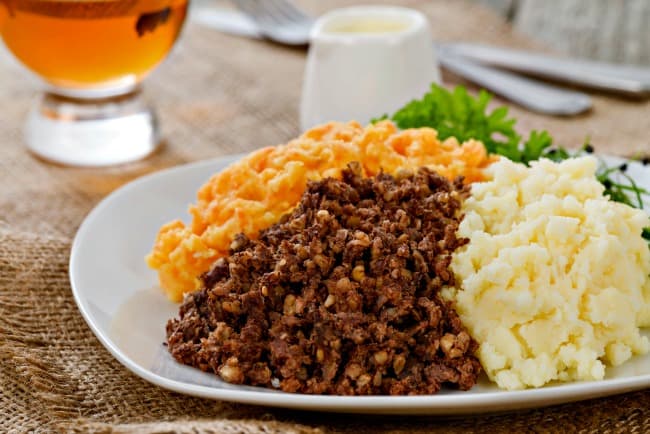
And first of all, let's be clear - in spite of many cartoons and caricatures, a haggis isn't a 'creature' but a food dish!
In fact it may the most well-known and famous item on the list of traditional Scottish foods.
The earliest historical mention of a haggis-like dish appeared in the 15th century.
But similar dishes may well have appeared as early as the 9th century, or before.
The haggis is made from a sort of sausage-meat made from the offal (or innards - lungs, heart, liver etc.) of a sheep.
These are boiled, then minced and mixed with onion, lightly toasted oatmeal, suet, stock and salt and pepper. It's all mixed together and put inside a sheeps stomach which is sewn closed and then the whole thing is boiled for several hours.
Now, I admit this may not sound all that appealing (and personally I don't think it even looks that good while cooking), but it's tasty and worth a try if you're ever in its' homeland.
Haggis is traditionally served at a 'Burns Supper' (or on 'Burns Night') accompanied by 'tatties and neeps' (aka potatoes and turnips).
Burns Night or Burns Supper celebrates the birthday (January 25) of Robert Burns, Scotlands' National Poet. Burns was so enamored of the haggis that he even wrote an entire poem devoted to it's splendors!
And of course, no Burns Supper would be complete without the traditional and world famous drink.... Scotch Whiskey!
Scottish Porridge
This is another traditional Scottish food that dates back to the very early days of Scotland.
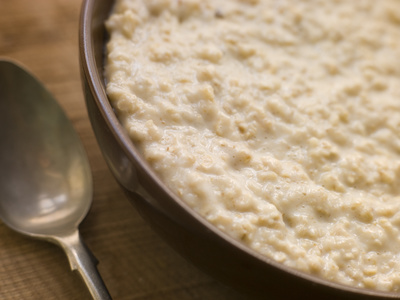 Scottish Porridge
Scottish PorridgeOats were used in many dishes, and porridge was probably one of the most common and versatile meals that the ancient Scots came up with.
Traditional Scottish porridge is made with 'porridge oats' (medium ground oatmeal, NOT 'quick cooking' or 'rolled' varieties), water and salt.
The oatmeal is added to boiling water and then boiled slowly with constant stirring to prevent lumps (lumpy porridge isn't good!). Salt is usually added about 2/3 of the way through the cooking process. It's served with creamy milk and, if you like, a little more salt on top!
Today many people prefer 'sweetened' porridge (or oatmeal as it's known in the US), and sugar, syrup or honey is often added to the unflavored variety. But that isn't the way Scottish porridge is made.
In more ancient times, Porridge may have been one of the worlds' first 'take-away' or fast-foods!
That's because the ancient Scots would cook up a huge pot of porridge, then let it cool and 'set', before cutting it into slices which they would put in a sack (or even their pockets) to be eaten later on that day!
Scottish Food Today
Although these days we don't have to rely on food that is locally-grown, raised, or hunted, traditional Scottish foods really haven't changed very much over time.
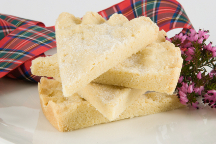 Scottish Shortbread
Scottish Shortbread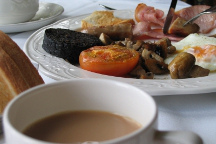 Scottish Breakfast
Scottish Breakfast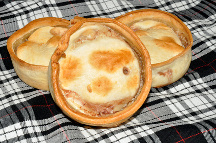 Scottish Pies
Scottish PiesBut, of course there's a lot more variety available, the influence of more exotic cultures, and newer methods and techniques for preparing meals.
What's in a full Scottish breakfast?
If you ask for a 'full Scottish breakfast' today, you'll get more than the porridge you would have expected hundreds of years ago!
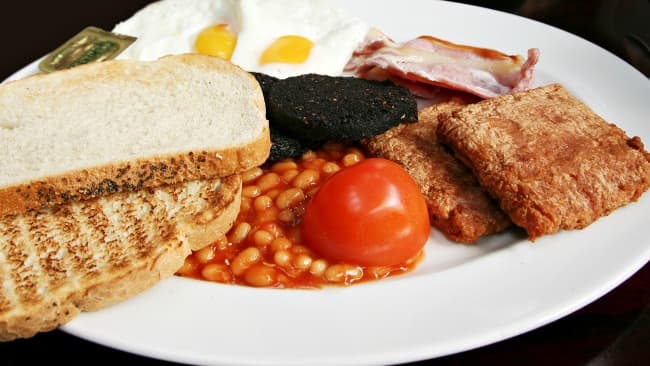
Your
plate might contain:
- Back bacon**
- Fried eggs
- Lorne sausage (square sausage unique to Scotland)
- Black pudding (a type of 'blood sausage')
- Fruit pudding (a 'sausage' made from suet, wheat flour, sugar and dried fruit such as raisins)
- Grilled or fried tomatoes
- Baked beans
- Mushrooms
- Potato scones
- Fried bread
** Back bacon is cut from the pig's loin (middle of the back) and is leaner and meatier than american-style bacon which is cut from a pig's belly). In the UK american-style bacon is called streaky-bacon, because of the strips of fat.
Now add some toast and marmalade or jam, and a cup of strong, hot tea and you'll be set up for whatever the day may bring!
But a gentle warning... when I indulge, the only thing I want to do was go back to bed to 'sleep it off' :o)
Scots Have An Impressive Sweet Tooth!
One aspect of the Scottish attitude to food that you might not be aware of, is just how much the Scots like their 'sweets' or puddings (aka 'desserts').
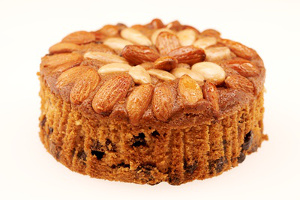 Dundee Cake
Dundee Cake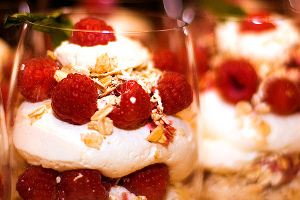 Raspberry Crannachan
Raspberry Crannachan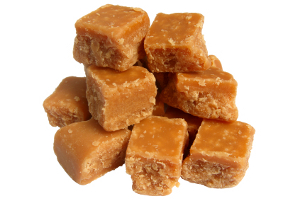 Scottish Tablet
Scottish TabletScottish pies, puddings, cakes, sweets (in this case I mean 'candies') and such are some of the best in the world. I think they rival the French pastries you get in Paris, and that's saying something!
In keeping with the wholesome and filling nature of most Scotland food, Scottish puddings and cakes are often dense, heavy and sweet.
Cakes and buns using dried fruit are very popular - think Dundee Cake (fruit cake topped with almonds), Black Bun (very dark and rich fruit cake), Clootie Dumpling (a fruit 'cake' which is steamed rather than baked) for example.
Soft fruit and apples or rhubarb appear regularly in pies and 'crumbles' (cooked fruit with a 'crumbled' topping made from flour, butter and sugar).
A lighter, but still traditional, dessert is Crannachan (made from whipped cream, whisky, honey, fresh raspberries and oatmeal) which is served in a tall glass, and is delicious!
And let's not forget 'extras' like scones, pancakes, biscuits (cookies), scottish tablet (sort of like fudge, but not as soft and very sweet) etc. etc. Can you tell I have a sweet tooth??
The inimitable Irn Bru!
First developed in 1901, Irn Bru is a non-alcoholic carbonated drink which has been the #1 selling soft drink in Scotland for generations (beating out Coca Cola and other major rivals).
This is due to both the unique flavor and the creative (and sometimes controversial) marketing of this 'national' drink.
The original, 'secret' recipe has a taste all it's own... why not try it yourself today... Irn Bru Scottish Soda
Try These Traditional Scottish Favorites...
Although simple and traditional Scottish cooking still prevails, Scotland now boasts some beautifully modern city centers which have tons of 'fine dining' restaurants featuring 'upgraded' versions of traditional Scottish food plus a huge variety of other cuisines.
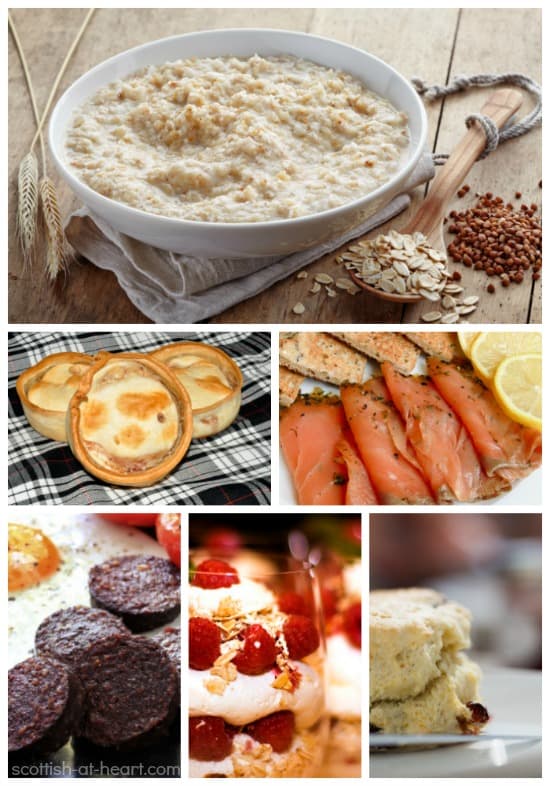
Even the 'fast food' side of Scotland food offers a variety of different themes and Indian, Chinese, Middle Eastern and Italian food jostles for position alongside the traditional Scottish fish and chips, fried Haggis... and yes, even those infamous deep-fried Mars bars!
If you're visiting Scotland here are some suggestions for traditional Scottish foods you should try while you're there:
- Lorne sausage
- Porridge
- Fruit pudding (and black pudding if you've a strong stomach)
- Scottish smoked salmon
- Smoked haddock
- Fish & chips
- Scotch pies
- Scones (including potato scones)
- Shortbread
- Cranachan
- Fruit bread
- Oatcakes
- Butter tablet
Find recipes for homemade porridge, scones, fruit bread, tablet and more HERE.
If you get a chance to visit Scotland, do your best to sample the traditional dishes - and remember that the small family run cafes and 'chippies' (fish and chip shops) are just as likely to have good food as the upscale 'posh' restaurants. Try them both and you won't be disappointed.
All in all, Scottish food is wonderful and don't ever let anyone tell you otherwise.
Enjoy!
Related Pages:
- Home
- Scottish Food
